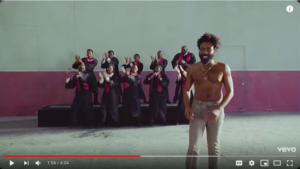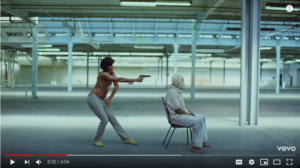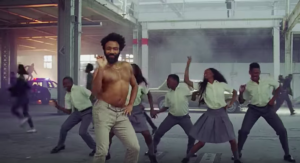Irony and Politics in Childish Gambino’s ‘This is America’
American rapper Childish Gambino’s music video ‘This Is America’ is an overtly political piece. The very title makes a very direct statement: what is contained in this video is America, a microcosm of a nation. Gambino uses irony to present an America of contradictions and with shocking imagery, he creates an uncomfortable atmosphere in which the viewer is forced to contemplate the meaning the lyrics alongside disturbing images. Viewed on YouTube over 411 million times, the reach of this video cannot be underestimated and has directly influenced other artists to use Gambino’s video as a framework onto which they can put their own cause[1]
The video relies on the political context of its moment of release (May 2018) to make sense both of the lyrics and visuals at a time of great political tension. Criticism of gun ownership and police violence that disproportionately affects African Americans have become more intense and Gambino’s video is a concerted effort to bring to light the ways in which people of colour are still systematically oppressed in the USA. It is no coincidence that the video contains a shot of Gambino gunning down a group of choir singers six months after a high-profile mass shooting in a Texas church[2] (see image 1). It is this environment of violence and racial division in which Gambino’s video should be understood.

Image 1
The main way the video articulates its politics is by constantly connecting violent and strange visual images to the lyrics of the song. Gambino’s lyrics claim “this is America” as the viewer graphically witnesses him shoot a hooded man in the back of the head while strapped to a chair (see image 2). He speaks directly to the spectator looking straight into the camera through-out while claiming this violence is synonymous with America itself. He demands the viewer’s attention not as a passive onlooker to a scene but bluntly repeats to them “this is America”, forcing them to make connections.

Image 2
Gambino reflects the dichotomy of American society through his lyrics set to an upbeat tone but with a very dark subject matter. He sings self-congratulatory lines such as “I’m so pretty” in a way that is made ironic by the shocking image of several people being gunned down. He appears to represent the dichotomy of the cultural power of a predominantly African American rap music industry against the institutional racism inflicted on the African American population as a whole by government and law enforcement, exemplified by the shooting of the hooded man in a chair at the beginning of the video (see image 2). Gambino also dances with an over-the-top enthusiasm which reinforces the irony of the piece. He makes exaggerated facial expressions while inflicting brutal violence upon African Americans contributing to the video’s deeply unsettling tone (see image 3).

Image 3
Much attention has been paid to the importance of the use of foreground and background throughout the piece. Cohan connects this to the video’s deliberate contradiction of Gambino’s strange and absorbing dancing drawing the viewer’s attention while violence is repeatedly displayed in the background alongside police cars[3] (see image 4). This, she suggests, alludes to the white audience’s consumption of black culture as a relationship in which pleasing elements are cherry-picked and the pain and plight of the black experience as a whole is ignored[4]. Gambino’s intentions appear to be to show the spectator the brutal reality of violence facing African Americans everyday while the general population remains placated by the American popular culture that is so dominant. By making this video an uncomfortable experience Gambino draws attention to these contrasting images of the American nation as one of violence and one of excess and distraction.

Image 4
While presenting its self very clearly as political ‘This is America’ is not calling for specific action or attempting to tell viewers what to think about it. Kurasawa’s description of testimony as “the cultivation of empathy against indifference” can be applied to look at this video as a form of political activism that doesn’t explicitly instruct but seeks to create more understanding[5]. Gambino’s video takes on a similar role to Kurasawa’s conception of testimony “with the aim of alerting the world”, specifically to the realities of racialised violence in the American context[6]. The last few moments of the video particularly appear to appeal to an emotional response from the viewer. Gambino runs from a pursuing crowd with a terrified expression on his face toward the camera. This could be interpreted as an attempt to force the audience to feel some small part of the unnerving, shocking and contradictory experience of being African American at this moment in time. Gambino himself has refused to explain the intended meaning of his video in interviews suggesting he doesn’t want to guide the spectator’s thought or reaction but to provoke them to make their own conclusions[7]. This is what makes the video so successful. The combination of its attention-grabbing imagery and bold message make it hard to forget as a viewer, achieving the effect of making the audience aware of the issue without demanding a monolithic response.
Despite being a commentary very specifically on the black experience in the USA, ‘This Is America’ resonated with struggles across the world. Feliciano-Santos claims “the real strength of the video is the conversations that came around it”[8]. This affect can be clearly seen in the response not only in opinion sharing online but also creatively. Artists from other nations used the success of ‘This Is America’ to bring light to the darker elements of other countries that have their own issues. These include ‘This Is Nigeria’ and ‘THIS IS IRAQ’ which deliberately imitate the tone and aesthetics of Childish Gambino’s video as well as replacing his lyrics with those that represent the specific set of problems these artists wanted to expose. In this way Gambino’s video not only provoked conversation regarding social issues in the USA but inspired those who saw parallels in their own experience to act to raise awareness of injustices.
Gambino has employed irony, and graphic imagery to shock viewers into paying attention to the issue of endemic racism and violence in the USA. He appears to seek to spread an awareness of the deep conflict apparent in American society. It is unclear if ‘This Is America’ has incited any specific tangible change but it has certainly succeeded in sparking not just an American but a global response to his message.
Watch ‘This Is America’ Here: https://www.youtube.com/watch?v=VYOjWnS4cMY
[1] “This Is America”, YouTube, accessed October 14, 2018, https://www.youtube.com/watch?v=VYOjWnS4cMY
[2] BBC, “Sutherland Springs: Texas church shooting leaves 26 dead”, BBC News, November 6, 2017, https://www.bbc.co.uk/news/world-us-canada-41880511
[3] Deborah J. Cohan, “Considering Rage and Gender in Donald Glover’s ‘This is America’”, Anthropology Now 10 no.2, (2018): 107.
[4] Cohen, “Rage and Gender”, 106.
[5] Fuyuki Kurasawa, “A Message in a Bottle: Bearing Witness as a Mode of Transnational Practice”, Theory, Culture & Society, 26, no.1 (2009): 92.
[6] Kurasawa, “Message in a Bottle”, 97.
[7] Sherina Feliciano-Santos, “Visibility and Agency: An Analysis of Media Responses to Childish Gambino’s ‘This is America’”, Anthropology Now, 10 no.2 (2018): 103.
[8] Feliciano-Santos, “Visibility and Agency”, 104.
